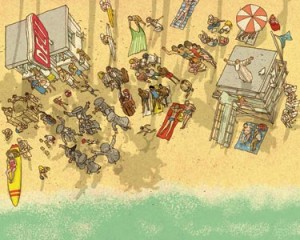 I immensely enjoyed Jewish Geography, the festival of ideas — and shmoozing — held on the UCLA campus Sunday.
I immensely enjoyed Jewish Geography, the festival of ideas — and shmoozing — held on the UCLA campus Sunday.
The festival posed difficult questions that trouble diaspora Jews, especially we Americans who survived the genocide of Europe and who evade the current mess in Israel.
I most enjoyed the panel “Things Past: Memory & Space,” confronting such profound questions as:
- How do we give concrete shape to memories?
- What role do memorial spaces play in modern Jewish culture?
- How do books and photographs function as memorials? How has Eastern Europe become a memorial space for many Jews?
- How does the Holocaust continue to haunt both Germany and Jewish memory and how is this shaping contemporary Berlin?
Speaking to these issues was Peter Eisenman, architect of the Holocaust memorial in Berlin, who admitted to a fully secular and assimilated childhood with scant Jewish identity. (He grew up with Christmas trees, never hearing of Chanukah.) By the completion of his Berlin project (proper name: Memorial to the Murdered Jews of Europe), Eisenman had come to terms with being a Jew — a result that twenty years of psychoanalysis failed to achieve. In memorable dialogue with author Daniel Mendelsohn, Eisenman also admitted his ambivalence toward architectural preservation … saving buildings that have lost their original occupants (and thus their souls?). Given my involvement with architectural preservation, I find this idea very provocative. The context was Eisenman commenting on the usefulness, or lack thereof, of saving buildings commemorating where Jews had dwelled in Shanghai … during that wacky ten-year period in which 20,000 Jews lived in Shanghai in a transitional existence between war-torn Europe and the new world — the U.S. This spoke to me based on three early encounters with abandoned neighborhoods that formed my fascination with ghostly architecture:
- exploring South Beach art deco district in Miami before its renovation … when it was in total disrepair and dilapidation in the 1970s. I didn’t even know the term art deco, I just knew that those decaying structures were amazing.
- crawling around old Shanghai architecture, esp in the former French concession during my first visits there in the mid-1980s. Shanghai was a stinking open sewer smelling of piss … and worse. Its buildings hadn’t been touched since the 1940s. A spooky time capsule. The whole city belonged under a cobweb.
- walking the streets of Manhattan’s Lower East Side from my perch in the East Village where I lived in a tenement building in the late 70s/80s. I was obsessed by the L.E.S. at that time — and deeply haunted by the remnants of teeming Jewish life.
The conference spent copious time exploring the notion that Jews are not people of “place,” but instead, people of time (evidence: predominance of the ritual calendar, focus on the weekly cycle around Shabbat, etc.). That Jews, getting their tuchas kicked hither and yon, are “people of the book”, i.e., people of ideas; people who can get out of Dodge with a backpack on an hour’s notice. The conference suggested that placelessness defines Jews. Israelis, of course, would disagree.
